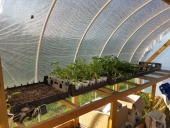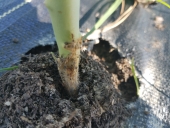Hi all,
We are now entering our first summer on the homestead! I would love any suggestions / feedback you may have... especially you Bryant Redhawk!
Garden outline:
> Transplants started in 2" soil blocks
> Rows are approximately 30"
> Raised rows consisting of mulched leaves and compost tilled in to the native clay soil, with a 1-4" layer of compost on the surface of each row.
> Tomatoes supported by 8 ft cut pine saplings buried 1 ft deep, florida weave and/or 2 strand tomato twine
> Fencing I use 6 ft T posts with 30lb fishing line approximately every 12 inches
> For organic fertilizers I have insect farms producing frass and redworm farms producing castings. I have not used much of either in any capacity other than seed starting in soil blocks. (still breeding)
Our goal is currently similar to Geoff Lawton's raised rows with adequate tilth and mulch. Hopefully this will allow us to grow varieties that require excellent drainage while retaining enough moisture. The native soil is has a large amount of clay and retains a ton of water.
A high production food forest with annuals and perennials that will produce adequate amount of food for us and our livestock.
Potential issues:
1. Planting too dense in many areas
2. Raised rows not yet mulched, height too high without mulch, roots struggle to hit nutrient dense water retaining clay layer
3. Seeds sown or transplants planted too late in the season (it's starting to get hot!)
----------
Current Date: 5/29
Trellis Row1|Row2: Malabar Spinach (Transplanted 5/20)
Row1: Pigeon Pea - Cajanas Cajan (Transplated 5/26), Pigeon Pea - Jamaican Gungo - Cajanus Indicus (Direct Seeded 5/27)
Row2: Incredible Corn (Direct Seeded 5/26)
Row3: Buttercrunch Lettuce, Bibb Lettuce (Transplanted 4/1), Broccoli (Transplanted 4/1) - no heads produced, fire ants eating stalks, Brussel Sprouts, Alisa Craig Onion, Red Russian Kale, Dinosaur Kale, Champion Collard Greens, Flash Collard Greens (Transplanted 4/15)
Row4: Bradley Tomatoes, 25 plants (Transplanted 4/15)
Row5: Bradley Tomatoes, 25 plants (Transplanted 4/15)
Row6: Bradley / Big Boy / Better Boy Tomatoes (Transplanted 4/15)
Row7: Wax Beans on side 1, Contender Green Beans on side 2, Middle Swiss Chard (Direct Seeded 5/4)
Row8: Texas 6 week aka Purple Hull Peas (Direct Seeded 5/7)
Row9: Dunja Organic F1 Zucchini (Direct Seeded 5/9)
Row10: Big Bertha Green/Red Bell Pepper, Serrano Hot Chili Pepper, Yellow Bell Pepper (Transplanted 5/13) All Star or Ozark Beauty bare root strawberry (Transplanted 5/13)
Row11: Ozark Beauty bare root strawberries in middle of row, Mary Washington asparagus on sides of row (Transplanted 5/15)
Row12: Yellow Onions (Transplanted 5/14)
Row13: White Onions (Transplanted 5/14)
Row14: Albion bare root strawberries (Transplanted 5/25)
Row15: Moringa (Sprouted direct seed 5/25)
Outside row: Comfrey, Symphytum officinale (Seeded 4/19 and transplanted 5/27)
> Tilled raised row, thin layer of compost, layer of cardboard, thin layer of compost, mulched with hay/grass (Ruth Stout method)
Large Lower row: Beauregard Sweet Potatoes, 100 slips in 3 rows, Texas 6 week Cowpeas planted inbetween rows
> Tilled
Outside fence 2 ft area, 240 linear ft: Wildflower Mix
> Tilled native soil, heavy clay
Irrigation: Rural water, a single 40' rain bird sprinkler mounted in the center of the 60' x 60' plot, 4 ft high.
----------
NO BED SPACE YET AVAILABLE FOR:
10 rooted comfrey plants, bocking 14, ready to plant
20-40 blocks of malabar spinach, ready to plant
85 soil blocks, egyptian spinach, ready to plant
young seedlings> jedi pepper, lunchbox pepper mix, island pepper, baron pepper (2 weeks old)
seed not yet planted
holland greens (tyfon)
butternut squash, waltham & metro pmr
clemson spineless okra
eggplant, orient express
cabbage, omero
yellow squash, tempest
cucumber, h-19 little leaf
TOO LATE IN THE SEASON?
tomatoes, brandywine, cherokee purple, striped german, amish paste, sun gold, sakura, black cherry
lettuce, coastal star, adriana, green butter salanova, deer tongue, buttercrunch
carrots, sugarsnax 54, purple elite
broccoli, imperial, green magic, happy rich, gypsy
beets, touchstone gold, avalanche, red ace
----------
Our property:
30+ acres that includes
1/2 acre pond, 2-12ft deep, stocked with brim, large mouth bass, catfish, feeds wet weather creek
4 acre mature hardwoods, near pond
5 acre immature pine plantation, access to huge supply of pine straw
6 acre lower pasture
4 acre upper pasture
1 acre house area
10+ acres volunteer trees, brush, blackberries and ruins (to be chipped!)
Our equipment:
Cub Cadet RT65 Tiller
Kubota 22.5hp 4wd tractor (Repairing electrical, adding loader)
Ford 1710 23.5hp 2wd tractor (Repairing engine or parting out, removing loader)
Titan Attachments BX42S Wood Chipper
5ft County Line Box Blade
4ft County Line Rotary Cutter
4ft Agric Tiller (planning to create mound attachment for raised rows)
Our planting accessories:
Ladbrooke Mini4 - 2" soil blocks
Ladbrooke Mini20 - 3/4" soil blocks
Ladbrooke Maxi 4" - Soil Blocker
Hori Hori
Weeding Sickle
Sheer Organza bags for seed collection
Hand Pruner
60% shade cloth
12ft x 10ft greenhouse
Livestock:
-chickens-
hatched on 2/5
10 barred rock hens
2 barred rock roosters
6 rhode island red hens
1 rhode island red rooster
9 golden comet hens
2 golden comet roosters (wont produce golden comets, oops)
17 freedom rangers (meat birds)
[in a chicken tractor, no egg production yet, 7 roosters culled thus far
were planning on trying to produce our own meat birds but may just order some cornish instead (price and weight gain efficient)]
our goal is to produce enough chicken feed to not have to purchase any at all.
blue butt piglets arriving in 4 weeks, will need to produce a lot of feed for these as well.
--- a lot of info here! all suggestions appreciated! here is a photo from the other day!









